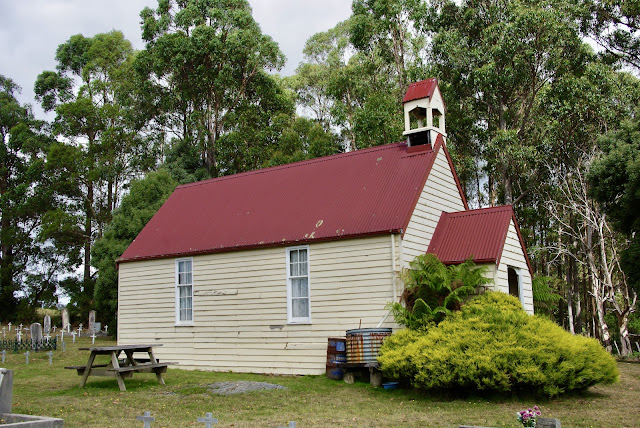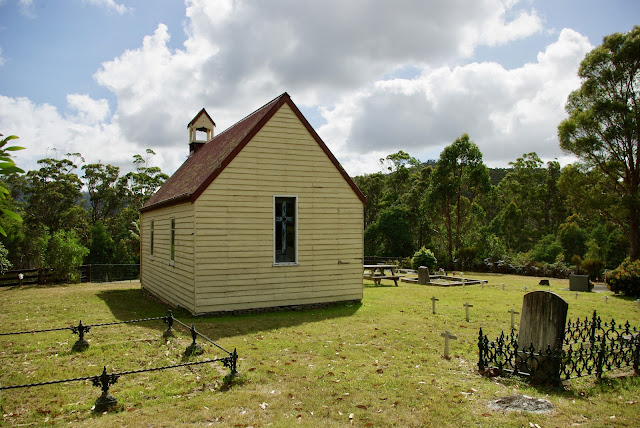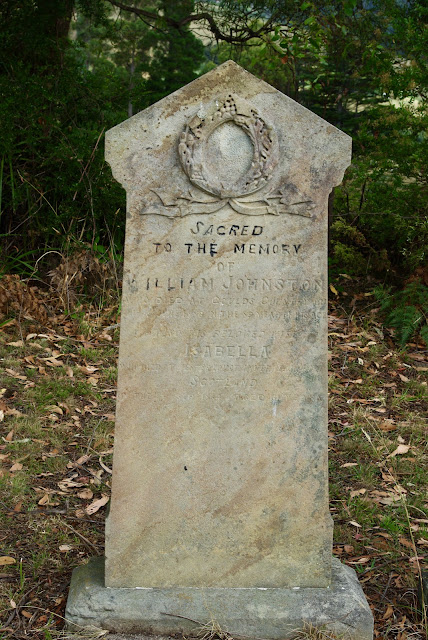No. 1269 - Gould's Country - Union Church (1874)
Gould’s Country a rural area off the Tasman Highway and is approximately 15 kilometres west of St.Helens. Although it is now virtually a ghost town, it once had a population of about 400 with a post office, school, three churches, council chambers, bank, hotel and a public hall. The town went into decline once tin mining in the district ceased. The district is named after Charles Gould, who was appointed the first Geological Surveyor in Tasmania (1859–69).
The foundation of the Union Church is linked to Benjamin Smith who arrived in Gould’s County in 1870. Smith was a devout Methodist and was instrumental in establishing a church. In 1871 when Bishop Charles Bromby passed through the district he observed:
“In Gould’s Country I found a young but enterprising body of settlers, who had carried with them to their seclusion a love of religious ordinances. As no ordained clergyman lives within fifty miles of them, it was gratifying to find that one settler reads the prayers of the Church to inhabitants each Sunday who assemble themselves with scarcely an exception…I found also that another neighbour previously collects the children at his house for Sunday School”.
In 1873 an acre of land to build a church was purchased for 30 shillings by Alexander Johnson, Isaac Chapple and Benjamin Smith. Construction was delayed until the following year when the debt on the land was settled. The earliest reference to the church appears in the Mercury in June 1874. The newspaper’s correspondent wrote:
“After a slight ascent, the new clearing for the little church is seen. Here, willing hands from neighbouring cottages have felled gigantic gum trees, and rolled away their immense trunks from the little space in the centre of destined to contain the building, which has just been commenced. A wooden structure it is to be, and should have been completed ere this, but the notion of the Government in charging the hard-working little community and for a single acre of land, and not permitting a stick on it to be touched, until all the money was paid…”.
As a Union church, the building was open to all denominations although in practice it was only used by Anglicans, Methodists and Presbyterians. In the early years the church was also used as a schoolroom. In 1884 the Mercury reported:
“A public day school has been conducted in this district for the last seven years. For the first three years the Union Church was kindly placed at the board’s disposal for use as a schoolroom, but owing to it standing in the centre of a burial ground it was not considered suitable”.
In 1890 a Wesleyan Methodist church was built at a more central location, about a kilometre from the site of the Union Church. This was the cause of some friction between Methodists and Anglicans and other members of the community. The Methodists sought to remove the Union Church pews and organ to the new building. This was opposed by some in the community who contemptuously referred to the new Methodist church as a “weatherboard cathedral”. Ultimately the Trustees of the Union Church refused the request which guaranteed the old church’s survival. Ironically, 15 years after the new Methodist church opened, services ceased and the building was removed to Pyengana in 1905.
Sources:
The Tasmanian, Saturday 18 February 1871, page 13
Mercury, Monday 29 June 1874, page 3
Mercury, Wednesday 25 June 1884, page 2
Daily Telegraph, Tuesday 11 November 1890, page 4
Mercury, Monday 17 November 1890, page 4
Daily Telegraph, Monday 1 December 1890, page 3
Daily Telegraph, Saturday 13 December 1890, page 3
Examiner, Thursday 1 April 1909, page 7
North-Eastern Advertiser, Friday 24 January 1941, page 2
The Mercury, Thursday 14 October 1993
The foundation of the Union Church is linked to Benjamin Smith who arrived in Gould’s County in 1870. Smith was a devout Methodist and was instrumental in establishing a church. In 1871 when Bishop Charles Bromby passed through the district he observed:
“In Gould’s Country I found a young but enterprising body of settlers, who had carried with them to their seclusion a love of religious ordinances. As no ordained clergyman lives within fifty miles of them, it was gratifying to find that one settler reads the prayers of the Church to inhabitants each Sunday who assemble themselves with scarcely an exception…I found also that another neighbour previously collects the children at his house for Sunday School”.
In 1873 an acre of land to build a church was purchased for 30 shillings by Alexander Johnson, Isaac Chapple and Benjamin Smith. Construction was delayed until the following year when the debt on the land was settled. The earliest reference to the church appears in the Mercury in June 1874. The newspaper’s correspondent wrote:
“After a slight ascent, the new clearing for the little church is seen. Here, willing hands from neighbouring cottages have felled gigantic gum trees, and rolled away their immense trunks from the little space in the centre of destined to contain the building, which has just been commenced. A wooden structure it is to be, and should have been completed ere this, but the notion of the Government in charging the hard-working little community and for a single acre of land, and not permitting a stick on it to be touched, until all the money was paid…”.
As a Union church, the building was open to all denominations although in practice it was only used by Anglicans, Methodists and Presbyterians. In the early years the church was also used as a schoolroom. In 1884 the Mercury reported:
“A public day school has been conducted in this district for the last seven years. For the first three years the Union Church was kindly placed at the board’s disposal for use as a schoolroom, but owing to it standing in the centre of a burial ground it was not considered suitable”.
In 1890 a Wesleyan Methodist church was built at a more central location, about a kilometre from the site of the Union Church. This was the cause of some friction between Methodists and Anglicans and other members of the community. The Methodists sought to remove the Union Church pews and organ to the new building. This was opposed by some in the community who contemptuously referred to the new Methodist church as a “weatherboard cathedral”. Ultimately the Trustees of the Union Church refused the request which guaranteed the old church’s survival. Ironically, 15 years after the new Methodist church opened, services ceased and the building was removed to Pyengana in 1905.
A few years after the Methodist church's removal the old Union Church was restored. In April 1909 the Examiner reported:
“A meeting of those interested in the renovation of the Union Church and burial ground was held in the church at Gould's Country on Wednesday night. The Methodist Home ,Missionary occupied the chair. If the necessary funds could be raised it was decided to replace the old surrounding fence with a new one; also to paint the church inside and outside, and roof it with galvanised iron. Two collectors were appointed, who are to collect for a month, and in the event of there not being sufficient money raised by this means, it was decided to hold a fair at some future date”.
In 1941 the Union Church again came under threat after a church hall at Priory burnt down in late 1940. A proposal was made to move one of the Gould’s Country churches (either St Gabriel’s Anglican church or Union Church) to Priory as a replacement. The proposal came to nothing after strong objections to the idea.
The Gould’s County Union Church is still stands and is maintained by a charitable trust. The cemetery is managed by the Break O’ Day Council.
* Note on the date of the church's establishment: While the date of the church's establishment is given as 1873; this was the year in which the land was purchased. The church's establishment should be dated to 1874, the year the construction of the building began. The church was completed in the same year.
“A meeting of those interested in the renovation of the Union Church and burial ground was held in the church at Gould's Country on Wednesday night. The Methodist Home ,Missionary occupied the chair. If the necessary funds could be raised it was decided to replace the old surrounding fence with a new one; also to paint the church inside and outside, and roof it with galvanised iron. Two collectors were appointed, who are to collect for a month, and in the event of there not being sufficient money raised by this means, it was decided to hold a fair at some future date”.
In 1941 the Union Church again came under threat after a church hall at Priory burnt down in late 1940. A proposal was made to move one of the Gould’s Country churches (either St Gabriel’s Anglican church or Union Church) to Priory as a replacement. The proposal came to nothing after strong objections to the idea.
The Gould’s County Union Church is still stands and is maintained by a charitable trust. The cemetery is managed by the Break O’ Day Council.
* Note on the date of the church's establishment: While the date of the church's establishment is given as 1873; this was the year in which the land was purchased. The church's establishment should be dated to 1874, the year the construction of the building began. The church was completed in the same year.
 |
| Benjamin Smith (1835-1927) Smith was a founder of the Gould's Country Union Church - photo supplied by Geoff Mellor |
 |
| The headstone of Benjamin and Mary Smith at St Helens Cemetery - photo supplied by Geoff Mellor |
 |
| Memorial plaque on the church gate. |
 |
| Undated photograph - Tasmanian archive and Heritage Office (Libraries Tasmania) |
 |
| A photograph of the Union Church before its most recent restoration in 1987 - Photographer: Frank Bolt |
A list of burials and photographs of headstones at the cemetery can be located <HERE>
The Tasmanian, Saturday 18 February 1871, page 13
Mercury, Monday 29 June 1874, page 3
Mercury, Wednesday 25 June 1884, page 2
Daily Telegraph, Tuesday 11 November 1890, page 4
Mercury, Monday 17 November 1890, page 4
Daily Telegraph, Monday 1 December 1890, page 3
Daily Telegraph, Saturday 13 December 1890, page 3
Examiner, Thursday 1 April 1909, page 7
North-Eastern Advertiser, Friday 24 January 1941, page 2
The Mercury, Thursday 14 October 1993






















Comments
Post a Comment